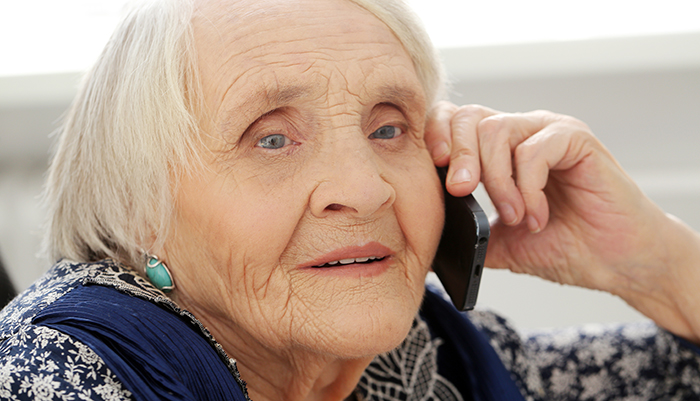Caring from a distance
Four long-distance strategies
 Your task is much more challenging from a distance. You are limited to what you can glean from the phone and from the visits you can afford to make. You will have to address the same tasks as would a nearby family member such as an accurate picture of what help is needed and what you can realistically do. In addition, you will need a team of locals to help you cover all the bases.
Your task is much more challenging from a distance. You are limited to what you can glean from the phone and from the visits you can afford to make. You will have to address the same tasks as would a nearby family member such as an accurate picture of what help is needed and what you can realistically do. In addition, you will need a team of locals to help you cover all the bases.
Stay in touch. This is a win-win. You stay current on issues, and your relative gets the emotional boost.
- Use the phone, email, and/or video calls such as Skype or Facetime. Connect at different times of day to see what’s up. Is mom sleeping a lot? What’s on the table at dinnertime?
- Ask about any injuries or falls. This information may not be volunteered.
- If your relative lives alone, ask for an “I’m up!” call or text by a preset hour.
Arrange for local help. Change is a constant. You will want to give neighbors and friends your contact information. Encourage them to call you if they have concerns or notice something is amiss. It’s also wise to consider hiring a professional in the field of aging. An Aging Life Care™ Manager can do an assessment and visit periodically. He or she can even go to medical appointments and help ensure that treatments are followed. An Aging Life Care Manager can also recommend local services and/or supportive housing situations as needed.
Plan ahead. When visiting, use your time wisely. Do things with your family member that are just plain enjoyable. But also consider
- addressing housekeeping issues. Fix potential hazards, such as rickety stairs and burned-out light bulbs. Piles of laundry or dirty dishes are other signs help is needed.
- getting into the kitchen. What is in the refrigerator? In the cupboards? Scorched pans may indicate your relative is forgetting to turn off the stove, a common sign of memory problems.
- checking the desk. Any overdue notices? Is the checkbook in order?
Keep documents in one place. At your home, keep a binder up to date with documents essential to health care and for money management.
Return to top
Easing the disruption of travel

There is one thing for certain in the life of a long-distance family caregiver: You are going to travel. And often on a moment’s notice!
You can ease the disruption by acknowledging that you have this “second life,” the one when you are periodically away. By treating it as a given, you can put systems in place to make even a sudden departure less stressful.
Your home responsibilities
- If you live with others, have a household meeting to talk about what to do whenever you are called away. Write down who will take on your chores. Then, when you do get the call, everyone can shift to the agreed-upon “Plan B.”
- If you live by yourself, arrange with others ahead of time to step in for common chores, such as pet care and watering the yard.
Finances and work
- Create a personal savings program for transportation expenses. Offset the financial stress of caregiving trips by putting aside a little money every month.
- Set bills to pay automatically online. Remove the need to worry about what has and hasn’t been paid!
- Save up your sick time, vacation time, or personal time off at work. If a protracted visit is needed, coworkers might even be willing to “donate” some of their paid time off to help.
- Arrange to continue some projects remotely. Bring a laptop or join meetings by phone.
Arrange a time for daily contact with those back home. Touching base reliably is beneficial for everyone. It maintains continuity in your “normal” life, and it is reassuring to know the day’s challenges can be discussed.
Work with a care manager. They can save you money and distress by advising whether you need to leave urgently or can wait.
Return to topVisits: More than just business
Stretched for time? No one knows that feeling better than family caregivers. Especially long-distance caregivers! There’s so much to do in the very limited time you will be visiting, it’s tempting to get efficient with nose-to-the-grindstone strategies.
For the sake of your loved one’s dignity and your own enjoyment, find ways to also bring your personal relationship to the fore.
A task-focused visit can inadvertently demean the person you care for. No one wants to be reduced to an item on the to-do list! For the receiver, there’s a big difference between feeling cared about and being cared for. Below are some tips.
- Slow down. Elders operate at a different pace than the work world. Before you walk in the door, take a few deep breaths and intentionally move out of the fast lane. Make “savoring the moment” one of the highest priorities on your to-do list.
- Schedule an activity that is purely for enjoyment. Ideally, ask your loved one what they would like to do together so the time spent has the most meaning to them. If that doesn’t yield ideas, think of an activity that you can propose specifically in the context of how it has meaning for you. “I remember when I was a kid and you used to take me to … I’d love for us to do that when I’m there.”
- Allow them their dignity. Humans have a strong need to reciprocate when given to. Otherwise they feel like a “freeloader” or a “burden.” Consider ways your loved one can give back. It does not have to be material gifts or paying for lunch (although you might let them if they offer, just to boost their self-esteem). Let them know you value their stories, humor, wisdom, or other treasures they can share.
Whether you visit once a month or once a year, remember that the reason you are there is much larger than the things that have to get done.
Contact us at 707.364.5285

